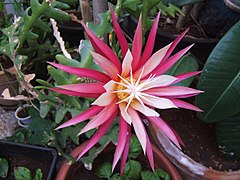| Habit | cacti-succulent
| |
|---|---|---|
| Height: | ⇕ | 10 ft"ft" can not be assigned to a declared number type with value 10. |
| Width: | ⇔ | 7 ft"ft" can not be assigned to a declared number type with value 7. |
| Lifespan: | ⌛ | perennial |
| Origin: | ✈ | Mexico: Chiapas |
| Bloom: | ❀ | early summer, mid summer, late summer |
| Exposure: | ☼ | sun, part-sun |
|---|---|---|
| Water: | ◍ | moderate |
| Features: | ✓ | flowers |
| USDA Zones: | 9 to 12 | |
| Flower features: | ❀ | white |
Selenicereus anthonyanus is a cactus species native to southern Mexico. Epiphytic in rainforests. 700–800 m alt. Seems to be of rare occurrence. It is grown as an ornamental because of its beautiful nocturnal flowers and unusual stems.
Stems scandent or climbing, branches in clusters at intervals along the stem, to 1 m long or more, 7–15 cm wide, flat with few areal roots; the lobes 25–45 mm long and 10–16 mm wide, somewhat tapered towards the rounded apex; areoles small, near central nerv, spines 3, short; epidermis green to yellowish green, smooth. Flowers 10–12 cm long, (10-) 14-17 (-20) cm in Ø, nocturnal, very fragrant; pericarpel 15–20 mm long, green, bracteoles 1–2 mm long, olive green, their axils with dirty gray wool, grayish-brown bristles and stout, pale brown spines, 1–3 mm long; receptacle 3–4 cm long, 1–5 cm in Ø, terete, bracteoles 3–6 mm long, ovate-lanceolate, the lowermost with wool and bristles, the upper naked, the uppermost 8–10 mm long, madder purple; outer tepals outermost 1–2 cm long, similar to bracteoles, inner 6 cm long, spreading-recurved, lanceolate, madder purple; intermediate tepals 5, lanceolate, acute; inner tepals ca 10, 6 cm, lanceolate-acute, erect-spreading, cream, outermost cream with lower margins madder purple; stamens short, 15 mm long, yellowish; style 6,5–7 cm long, 6mm thick above the throat, in the throat abruptly contracted to 4mm thick, cream, stigma lobes 12-14, lanceolate, 16–18 mm long. Fruit ovoid, 6 x 5 cm long, fragrant, areoles 4 mm with spines 1–2 cm, dark green. Seeds 2 x 1,5 mm, black.
Cultivation
An easily cultivated, fast growing epiphyte. Needs a compost containing plenty of humus and sufficient moisture in summer. Should not be kept under 15°C (59°F) in winter. Can be grown in semi-shade or full sun. Extra light in the early spring will stimulate budding. Flowers in late spring or early summer.
Propagation
Pests and diseases
Varieties
Hybrids:
- 'Corinna Paetz' (S. anthonyanus x 'Feuerauber')
- ×Disoselenicereus 'Mandarin' by Dr. Stauch (Disocactus x smithii x S. anthonyanus)
- ×Disoselenicereus 'Noris' by R. Gräser (Disocactus speciosus x S. anthonyanus).
- '×Disoselenicereus 'Wormatia' by Dr. Stauch (Disocactus x smithii x S. anthonyanus).
Gallery
References
External links
- w:Selenicereus anthonyanus. Some of the material on this page may be from Wikipedia, under the Creative Commons license.
- Selenicereus anthonyanus QR Code (Size 50, 100, 200, 500)
